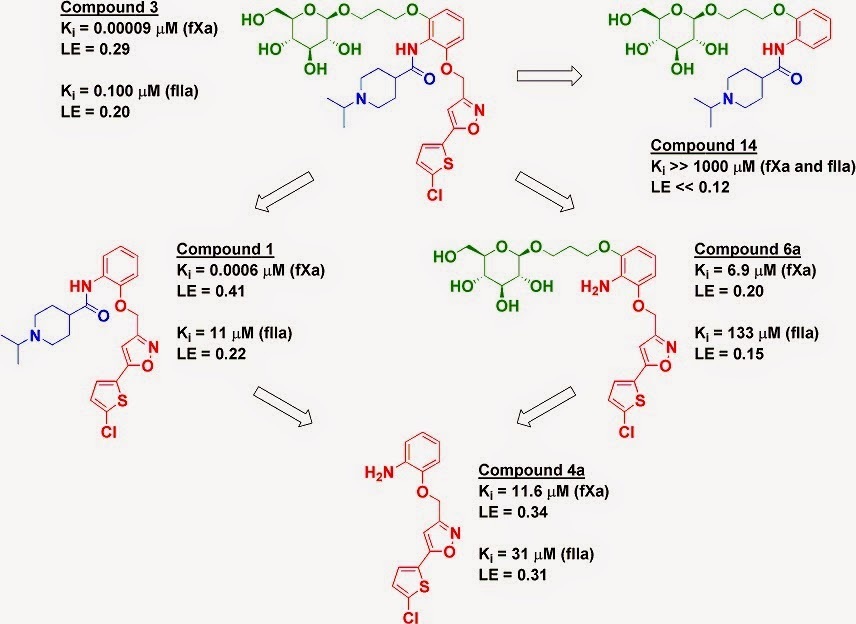Most drugs interact non-covalently with
their target. The conventional wisdom was that covalent drugs – especially
irreversible ones – would have dangerous side effects. Although this is still a
concern, the success of drugs such as ibrutinib and dimethyl fumarate has
caused a resurgence of interest. In a new paper in Nature Chemical Biology, Brian Shoichet, Jack Taunton, and
colleagues at the University of California San Francisco describe how
computational chemistry can be used to find new covalent inhibitors.
The researchers created a modified version
of the program DOCK called – wait for it – DOCKovalent. Happily, they have made
this available for free to anyone. To start, you upload your crystal structure
and choose which amino acid residue you are interested in targeting. You can
then pick from 9 different libraries of various electrophiles, each covering a
different class of covalent “warhead”: epoxides, aldehydes, etc. There are
about 650,000 molecules in total, roughly half of which easily qualify as
fragments, with the rest being lead-like (still < 350 Da). Each molecule is
either commercially available or readily synthesized in one or two steps.
The program then virtually links each
molecule with the selected protein residue (typically cysteine or serine) and calculates
scores based on predicted van der Waals and electrostatic interactions as well
as desolvation. Multiple conformations of each ligand are sampled (with
fragments there are not that many) as are different rotamers of the
nucleophile. Users then manually inspect and test the top hits.
The researchers first benchmarked the
program against four proteins with known covalent inhibitors, where it performed well. In
the case of the bacterial protein AmpC β-lactamase (which we previously
discussed here), the program retrospectively predicted the correct structure of
15 out of 23 known boronic acid ligands. In one case where the prediction
differed from the reported co-crystal structure, the researchers re-determined
the co-crystal structure at high resolution and found that DOCKovalent was
actually correct.
Thus confident, the researchers docked 23,000
commercial boronic acids against AmpC and selected 6 on the basis of score and
structural novelty. Of these, 5 had inhibition constants of 3.55 µM or better,
with the best being 40 nM. A crystal structure of this compound bound to the
protein led them to purchase 7 additional compounds, one of which had Ki
= 10 nM and a ligand efficiency of 0.73 kcal/mol/atom. Most of the molecules
were also selective against 4 other proteases and were able to reverse
antibiotic resistance in AmpC-expressing bacteria.
Of course, by design all of these molecules
have a boronic acid warhead; will any such molecule inhibit this enzyme? To
find out, the researchers tested 5 low-scoring molecules and found that 4 of
them showed, as hoped, less than 10% inhibition at 10 µM. However, a fifth molecule showed reasonable inhibition, with Ki = 3.2 µM. To understand this
false-negative, the team solved the crystal structure of the molecule bound to
AmpC. Interestingly, the molecule bound in a conformation different than had
been predicted – one that also required conformational changes in the protein,
which are not allowed in DOCKovalent.
This looks like a very nice approach. Of course, it does require a crystal structure (or at least a good model). Also, as mentioned above, the fact that the protein is kept rigid means the program will be unable to detect ligands that bind to cryptic pockets, so there is still plenty of opportunity for empirical surprises. Still, the fact that DOCKovalent is freely available will hopefully encourage people to give it a try on their favorite protein.
The researchers took a similar approach to
seek novel inhibitors of the kinases RSK2 and MSK1 using reversible
cyanoacrylamide-containing molecules (previously highlighted here). Here too
the researchers were able to identify selective nanomolar cell-active
inhibitors.
This looks like a very nice approach. Of course, it does require a crystal structure (or at least a good model). Also, as mentioned above, the fact that the protein is kept rigid means the program will be unable to detect ligands that bind to cryptic pockets, so there is still plenty of opportunity for empirical surprises. Still, the fact that DOCKovalent is freely available will hopefully encourage people to give it a try on their favorite protein.




 So, in the end, I was pleasantly surprised. This ended up being nice work with a good breadth of work. I don't know if this makes it into the "lead-like" space or will remain in the "tool" space, but I like to see this kind of work, especially from academic groups.
So, in the end, I was pleasantly surprised. This ended up being nice work with a good breadth of work. I don't know if this makes it into the "lead-like" space or will remain in the "tool" space, but I like to see this kind of work, especially from academic groups. 


